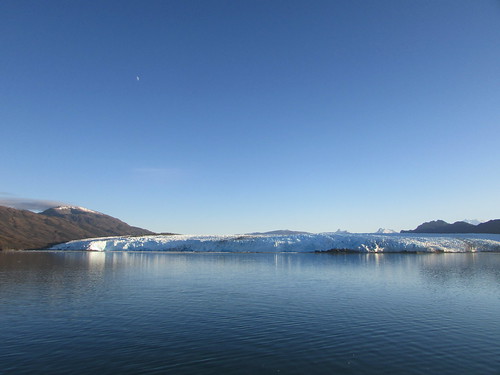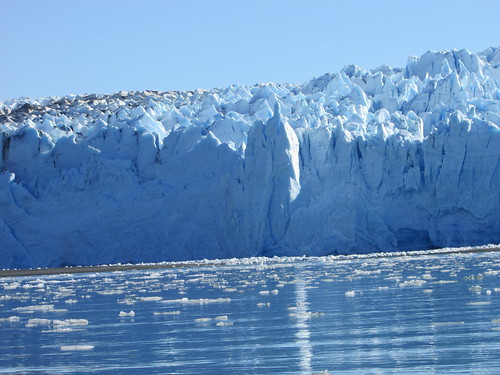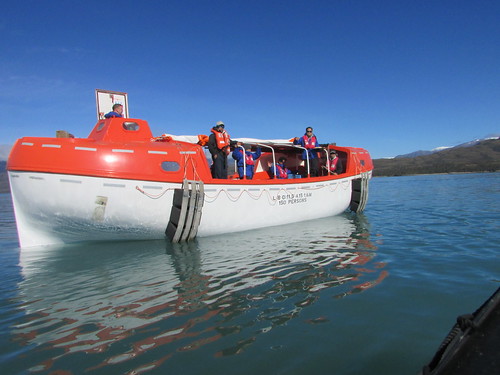I awoke to a glorious sunny morning at our anchorage a mile or so short of the glacier face of the Pio XI glacier, originally called the Bruggen Glacier. This glacier is the largest outflow to the west from the Southern Patagonian Ice Field.
Glacier theory
Glaciers are produced in land areas where annual snowfall exceeds the rate of annual melting. Over a long period, as the thickness of snow increases, gravity crushes the lower layers of snow, expelling entrained air bubbles and creating dense, clear ice under pressure. Gravity also causes the dense ice mass to slowly slide towards lower ground at a speed determined by the topography and the frictional resistance to the ice movement presented by the underlying rock. This rock becomes fractured and ground by the ice and carried along with the glacial movement, often as a dark-coloured ‘moraine’. Where a glacier meets a fjord, pressure from the glacier further ‘upstream’ on the unsupported ice causes fracturing and the creation of an exposed glacier front. As pressure is relieved within the ice, the glacier face continues to fracture and ice breaks away in a process called ‘calving’.
The location
Pio XI is the longest glacier in the southern hemisphere outside Antarctica at about 64 km long. Whilst most glaciers are currently ‘in retreat’, between 1945 and 1976, this glacier advanced by around 5 km. The glacier face is 4.5 km wide but gives the impression of being smaller because, viewed from the fjord, there is little to give a sense of scale. In the case of Pio XI, the glacier is set between green, wooded hills and the proximity of mature trees offers some hint as to the true size of the glacier but it is difficult to avoid underestimating the scale of such an unfamiliar object.

Pio XI Glacier.
The Zodiac Cruise
Conditions were ideal for a Zodiac Cruise. Since it was planned that we would be on the water for 1.5 hours, we were warned to wear sufficient clothing to remain warm whilst sedentary. I made sure that I had a substantial breakfast and was ready in good time for when my group was called by public address to deck 3 for boarding the Zodiacs.
The first Zodiac away from the ship was driven by botanist Hans Peter in one of the larger Zodiacs. I was in the second Zodiac, driven by Luke and, with just 8 passengers, we had plenty of room. We sailed towards the glacier face which rose like a cliff from a ‘beach’ of ground-up rock of moraine materials.The glacier face was heavily fissured as pressures within the glacier had been relieved by cracking. Quite frequently, a loud rumbling like thunder could be heard as the glacial ice ‘re-arranged’ itself and, on a few occasions during our Zodiac cruise, this was accompanied by a visible fall of ice producing a white spray as the internal pressure produced an explosive release of material. The internal pressure had also resulted in crevasses in the top surface of the glacier leaving a very uneven appearance.

Pio XI Glacier Zodiac Cruise: Cliff-like glacier face and heavily-crevassed top surface.
As we came a little closer, the sea was littered with ice ranging from a few inches to a few feet across which had fallen from the glacier front. Sometimes the shape of the ice suggested a shard which had broken away from the glacier face, but often partial thawing and re-freezing had produced a strangely-shaped object, like some example of modern art. Only around 10% of each lump of ice is visible above the surface so care is needed when passing through ice debris called ‘brash ice’ and ‘bergy bits’.
Luke identified two types of ice. The first type has a white appearance, like frozen snow. The colour is produced by small air bubbles trapped in the ice. The second type is translucent without bubbles where pressures within the glacier have expelled the trapped air, leaving frozen water. This type of ice, in a large piece, takes on a bluish tinge because of the differential light absorption of water and water/air.
Luke also demonstrated the effect of holding a small, flat piece of ice containing air bubbles between both palms. As the body heat warms the ice, release of trapped air produces a series of audible ‘pops’, each accompanied by a slight vibration which can be felt. The air may have been imprisoned for thousands of years and laboratory tests now exist for releasing the air from samples of ice and analysing it to determine changes in the earth’s atmosphere.
Hans Peter, the botanist, presented our Zodiac with a piece of Kelp he’d found floating. Kelp grows rapidly as a series of broad leaves a couple of metres long, interconnected by flexible stems with air bladders. Each leaf is green, slightly corrugated and covered with a thin layer of mucous material. Normally, one end of the plant would be anchored to rock but wind and tide can break the stem, as had happened to the sample we examined.

Pio XI Glacier Zodiac Cruise: Luke displays the kelp presented by Hans Peter.
We spent some time cruising across the face of the glacier but keeping a respectful distance and examining the floating ice. At one location, the ice contained moraine material and was dark coloured. As the sun melted the ice, the crushed rock was released as sediment.
Crew Safety Drill
We had been advised that the ship’s crew were carrying out a safety drill whilst we were on the Zodiac Cruise but we didn’t know the details so, looking back at the ship, it was a surprise to see that one of the lifeboats had been launched. At the same time, a strange noise alerted us to the fact that we were being filmed by Ray from his drone hovering above us! I was delighted when we headed towards the lifeboat as I had not seen one in the water, only stowed on the davits.

Pio XI Glacier Zodiac Cruise: One lifeboat had been launched in a Crew Safety Drill.
Silver Explorer has two motorised lifeboats, each capable of holding 150 people. We drew alongside the lifeboat and I was amazed to see various members of the restaurant staff on board who presented us with a glass of champagne, cake and a variety of sweetmeats. The captain had agreed to let an essential training exercise serve a second, delightful purpose.
Our Zodiac then returned us to the ship after a wonderful cruise. Noticing that the lifeboat was about to be recovered, I hurried to the observation deck in time to see the electric winch lift the lifeboat out of the water and swing the davit arms and lifeboat into the ‘stowed’ position.

Aboard 'Silver Explorer': Following the Crew Safety Drill, the lifeboat is returned to the davits.
Once all the passengers were back on board and the Zodiacs recovered, we set off south again, this time on a ‘leg’ of 447 miles to Punta Arenas which would take more than one day. Meanwhile, I had a little time to work on the computer before lunch and a programme of lectures was offered during the afternoon.
Related Posts
Next post describing this trip: On to the Strait of Magellan.
All posts describing this trip: Chilean Fjords.
My pictures
Where necessary, clicking on an image above will display an 'uncropped' view or, alternately, my pictures from this (and earlier) trips may be selected, viewed or downloaded, in various sizes, from the albums listed:-
Pictures on the Pio XI Zodiac Cruise are here.
Pictures aboard 'Silver Explorer' are here.
All my pictures of Chile can be found in the collection Chile.
[Pictures added 13-Jan-2017]
